SilencerCo Advances Suppressor Technology with the End User in Mind
SilencerCo Advances Suppressor Technology with the End User in Mind
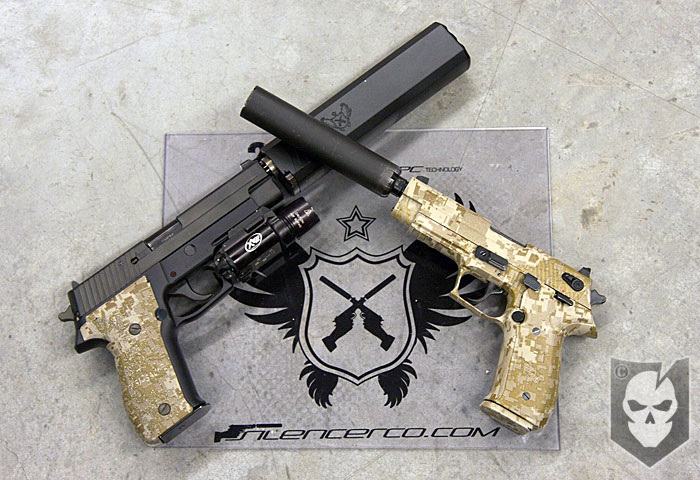
ITS was recently contacted by SilencerCo to discuss the opportunity in taking a trip out to Salt Lake City, Utah to get hands-on with their suppressors.
Little did we know what a true learning experience it would be and how much information we’d walk away with. We all thought we knew a thing or two about suppressors, but sitting down with the crew from SilencerCo was a truly educational and humbling look into the technology and innovation that goes into suppressor manufacturing.
We hope to share all that we’ve learned with you today and know you’ll leave this article with a new found appreciation for not only suppressors in general, but especially for the game changing innovation going on at SilencerCo; just like we did.
Suppressors or Silencers?
Before we get into the meat of this review, it’s important that we go over some terminology and a little history lesson. First off, suppressor or silencer? They’re the same thing, but for the sake of properly describing their function, we’re going to refer to them as suppressors. Technically they should be called sound suppressors as they don’t “silence” a weapon.
No matter what kind of sound Hollywood uses in movies, you still “hear” a suppressor. To accurately describe what they do, it would be eliminating muzzle flash and reducing the sonic pressure. That reduction in sonic pressure is what “quiets” things down.
Hiram Maxim is a name you should be familiar with, as he’s credited with inventing the Maxim Silencer. The Maxim was the first successful suppressor commercially available starting around 1902. Maxim also had a hand in earlier auto muffler technology.
It’s also important to talk about the proper definition of “hearing safe.” OSHA (Occupational Safety and Health Administration) has a chart here on their Website which states that for an 8-hour workday the A-weighted sound average shouldn’t be over 90 dB. However, “exposure to impulsive or impact noise should not exceed 140 dB peak sound pressure level”
So according to OSHA, anything under 140 dB that’s not a prolonged exposure level should be “hearing safe.” As you’ll see in the testing section later in this article, all suppressors tested fell under a 140 dB A-weighted average. It’s amazing how much a 1 dB difference made though.
Benefits
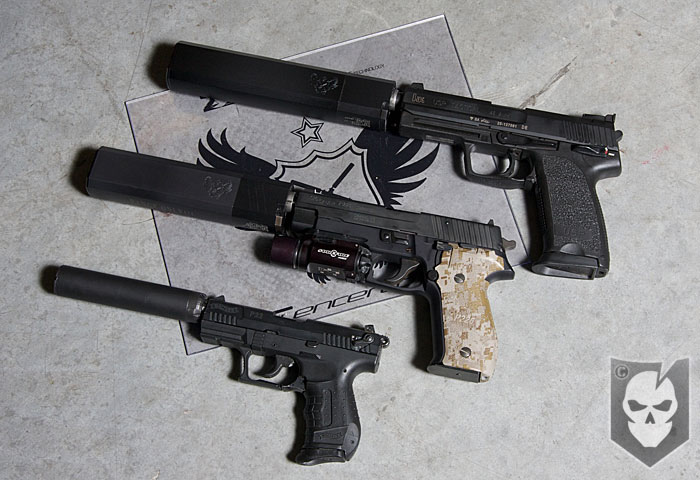
So why would you want to own a suppressor? To quote Gary Hughes, National Sales Manager at SilencerCo, “A suppressor takes away all the things that suck about shooting.” The blast, noise and recoil are all greatly reduced when shooting a suppressed weapon.
The entire time we were at SilencerCo shooting suppressors none of us were using ear pro, except when establishing the baseline by shooting unsuppressed host weapons.
Felt recoil is also greatly reduced when shooting suppressed. Escaping gas is trapped, changing the recoil impulse. There’s also less muzzle rise which equates to increased shot control and less time to get back on target for follow-up secondary and tertiary shots.
In addition to all these benefits, we can’t forget about flash reduction. While muzzle flash isn’t as much of a concern on pistols as it is on centerfire rifles, the need to mask shooter location is important when you’re dealing with an adversary that’s shooting at your muzzle flash. For the LE guys reading this, you definitely don’t want the foot and a half fireball from your weapon blowing up the meth lab you’ve just busted.
You also can’t be a card carrying cool guy without a suppressor; the ladies just won’t look at you the same.
SilencerCo
While still young for a company in the suppressor industry, don’t let SilencerCo’s 3-year history lead you to believe they’re not a major player. The fact remains that they’re truly innovating suppressor technology in an industry that hasn’t moved much in a long time.
This isn’t an attempt to discredit their competitors, it is however a statement that accurately reflects the traditional round can, non-user serviceable suppressors that are available from numerous manufacturers. While you may think suppressor technology is all about who can build a quieter suppressor, we hope this article will change your viewpoint.
SilencerCo started with a realization by Owner/CEO Joshua Waldron and Owner/Chief Engineer Johnathon Shults that the suppressor industry had room for improvement. They teamed up with Owner Mike Pappas to collaborate on their goal to build a better 22 suppressor.
The largest issues with then current 22 LR suppression were ease of maintenance and the fact that typical 22 fouling meant a definite service life on suppressors. The company is here today because of the ingenuity that went into their 22Sparrow, which is geared around an end-user serviceable suppressor that makes cleaning a snap; even with heavy fouling.
Roundtable Interview with Gary Hughes and Mike Pappas
Products
Currently SilencerCo produces the 22Sparrow, which was recently upgraded to stainless steel, as well as the 9 OSPREY, 40 OSPREY and 45 OSPREY. All suppressors are available in black with the exception of a special dark earth edition of the 45 OSPREY.
22Sparrow
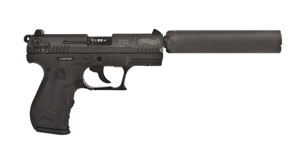 The development of the 22Sparrow marked a departure from traditional 22 LR suppressors that were sealed and required shipment back to the manufacturer to cut open, clean and maintain. Cleaning a 22 suppressor isn’t even optional, as fouling and lead deposits build up and cause the suppressor to get heavier and louder.
The development of the 22Sparrow marked a departure from traditional 22 LR suppressors that were sealed and required shipment back to the manufacturer to cut open, clean and maintain. Cleaning a 22 suppressor isn’t even optional, as fouling and lead deposits build up and cause the suppressor to get heavier and louder.
With the ingenious design of the Sparrow, Mike’s cocktail napkin idea, the end-user can completely disassemble the suppressor for cleaning and maintenance. On the Sparrow, the main tube is simply a sleeve that contains the baffle stack and “half pipes.” These half pipes clamshell around the baffle stack and ensure that no matter how much fouling occurs, you’ll still be able to easily pull the baffle stack through the outer tube for disassembly.
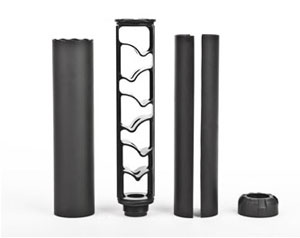 A common issue we’ve seen first hand with other take-apart designs is that as fouling builds up it gets harder and harder to push the baffle stack through that fouling in the main tube for disassembly. The half pipe design of the Sparrow solves this issue by allowing the end-user to pull the fouling away from the baffle stack, not through it.
A common issue we’ve seen first hand with other take-apart designs is that as fouling builds up it gets harder and harder to push the baffle stack through that fouling in the main tube for disassembly. The half pipe design of the Sparrow solves this issue by allowing the end-user to pull the fouling away from the baffle stack, not through it.
All parts on the 22Sparrow are user replaceable and can be ordered through SilencerCo. The outer tube is the serialized part you pay the tax stamp on, (more on laws later) which means that barring complete destruction of the suppressor the end-user is able to replace anything themselves without having to pay for another tax stamp.
The newly redesigned 22Sparrow is now made in heat treated 17-4 PH Stainless Steel, is an inch shorter, full auto rated, much quieter and can shoot 5.7×28 FN. In addition to the 5.7 cartridge the Sparrow is rated and warrantied for use with all rimfire rounds .22 diam and under, such as .17 hmr and .22 mag.
OSPREY
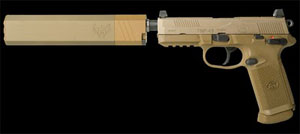 SilencerCo is very much a design-goal oriented company, as they don’t start with a preconceived notion of what a product should look like, but rather how to achieve the goals of what they want to fix with an existing suppressor design.
SilencerCo is very much a design-goal oriented company, as they don’t start with a preconceived notion of what a product should look like, but rather how to achieve the goals of what they want to fix with an existing suppressor design.
The primary goal that SilencerCo wanted to achieve with the OSPREY was best-in-class sound suppression from .45 ACP, a popular and notoriously difficult cartridge to suppress. The secondary goal was a low signature on host weapons, in order to utilize factory sights without modification or needing a dedicated suppressor host weapon and holster.
What was born out of these goals was the acentric OSPREY who’s bore centerline location resembles that of the very first Maxim Suppressors. Maxim’s suppressors were a round design, but had the bore hole near the top of the circle. This was due to shooting these first incarnations on many iron sight weapons. SilencerCo resurrected this design because it accomplished their secondary goal; lessening the amount of sight obstruction and more importantly, your target.
This acentric placement also allows increased suppressor volume to be gained by shifting the baffle stack down, equating to a 30% gain in volume when compared to similar sized round suppressors. Out of this placement also came the slim form that allows the OSPREY to be holstered in many modular holsters; like the Down Range Gear Modular Insert Holster. An ITS Exclusive bit of information right from Mike Pappas is that it also won’t roll off your truck!
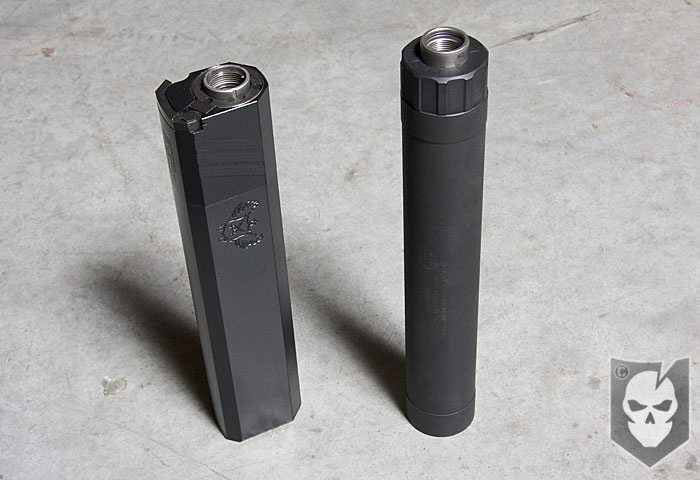
Let’s touch briefly on holsterability; this doesn’t mean that you’re going to carry a pistol-mounted suppressor inside of a holster to draw quickly when needed. It means that in situations when you’ve attached your suppressor and now find yourself needing to go hands-on; you can retain your pistol to do so instead of not being able to do what you need to.
Unlike 22 suppressors in general, the OSPREY has far less maintenance needed. Largely all that’s needed is to remove the piston/Nielsen device and ensure fouling hasn’t hampered the ability of the recoil booster to move properly. When adding the weight of a suppressor to a recoil operated pistol, a recoil booster or Nielsen device is needed to ensure the recoil action remains functional. The baffle can also be cleaned on the OSPREY by simply spraying it out with brake-free or carburetor cleaner.
The OSPREY is available in 9mm, .40 and .45 caliber configurations and maintains excellent sub-caliber performance through the use of interchangeable pistons. Anytime you shoot sub-diameter projectiles through a larger exit diameter you have decreased sound suppression performance. Shooting 9mm through the 45 OSPREY we only saw around a -3dB decrease, which still rivals many dedicated 9mm suppressors on the market.
Indexing the OSPREY
Building a 45 OSPREY
The last item we’d like to touch on with the OSPREY is another SilencerCo innovation that has to do with the serialized part. On the OSPREY, the serialized part is the small billet backcap. The ensures that the area most prone to damage in a baffle strike can be replaced by SilencerCo without having to replace the serialized part. Like the 22Sparrow, this prevents you from having to purchase another tax stamp. So far SilencerCo tells us they haven’t had anyone that’s been able to damage the backcap and have only had a few warranties, which have been turned around in 24 hours.
Wet vs. Dry
If you’re not familiar with the ability to shoot a suppressor “wet,” allow us to provide some background. All of SilencerCo’s testing data available online, as well as the testing we conducted (shown below) was dry; meaning no water or liquids were added to the suppressors and were shot as they come from SilencerCo. Most suppressors have the ability to add water or liquid to lessen the first round “pop” that’s commonly the loudest shot from a string.
SilencerCo states that there’s really no reason to shoot the 22Sparrow wet because the reduction gained is negligible and significantly adds to the cleaning duty. However, you do get significant gains with the 45 OSPREY which is already advertised as hearing safe. SilencerCo favors Wire Pulling Gel, which after we saw in action is what we’d recommend as well (never use anything flammable!). The gel is commonly used for lubrication when pulling wires through conduit and won’t freeze!
Water works, but how do you pre-stage water? With the gel, you can squeeze 5cc’s into your suppressor and have it ready to go when you need it; not having to worry about that first round pop. Shooting the OSPREY wet we saw sound levels slightly above dry 9mm suppression.
Subsonic vs. Supersonic
Subsonic = below the sound barrier, Supersonic = above the sound barrier; pretty simple, right? So why shoot subsonic ammo? Ballistic crack. Anytime a bullet breaks the sound barrier, meaning it’s traveling at a speed faster than around 1100 fps (feet per second) you hear the small sonic boom referred to as ballistic crack. Out of a suppressed weapon, the sound is omni-directional and can be heard more down range than at the shooter. This can mask a shooter’s location and is why some say “a suppressor doesn’t make you silent, but it does make you invisible.”
Using subsonic ammunition will increase the effectiveness of a suppressor, but has notoriously not equated to much in dB reduction. We feel this is largely due to the common mil-spec testing standards, which we get into below, only metering through a microphone 1 meter to the left of the shooter. This obviously doesn’t pick up the downrange ballistic crack very well.
In addition to the dB reduction, the bullet is traveling at slower speeds and will decrease range. This is all relative though as the situation will dictate what’s more important, the range or the noise reduction gain from subsonic ammunition. Subsonic ammo uses a heavier bullet to make up for the decreased velocity and maintain the same energy level as supersonic rounds.
There’s another option for eliminating the ballistic crack without using subsonic ammunition, and that’s by reducing the velocity before the bullet leaves the barrel. The best example of this is a weapon with an “integral” suppressor, such as the MP5SD. The vented barrel allows a supersonic round to exit as subsonic velocity. The downside is a true reduction in energy and effectiveness.
Suppressor Ownership
Rather than regurgitate the great guide to owning a suppressor that SilencerCo has put together, we’ll just link to it here. Suffice to say that they’ve always been legal under federal law, but only legal to own in 38 of the 50 states with an ATF application, $200 tax stamp and background check. Our advice is to get the hell out of those other 12 states! Why are you still there?
Testing Standards
While at SilencerCo we sat down with Owner and Chief Engineer Johnathon Shults and learned all about the unique testing software that they’ve been using for the last year and a half.
John mentioned wanting to reset the testing standard to take duration into account and incorporate more mics into play. With two mics at the shooter to mimic the stereo sound we hear and a mic downrange to perceive duration, you’d get a more accurate picture of the true dB rating of a suppressor. Duration is important because if the human ear hears a quick 120 dB noise and a one second long 110 dB noise, it perceives the 110 dB noise to be louder.
What’s Next?
So what’s next for SilencerCo? They’re currently in the R&D process on their 5.56 and 7.62 rifle programs and hope to bring more game changing innovation into those markets as they’ve done with the 22Sparrow and OSPREY. SilencerCo notes that they welcome anyone to sound test their suppressors; they’ve had competitors sound test their suppressors, just as they sound test their competitors’.
Our Experience
Visiting SilencerCo was a tremendous opportunity and one we truly learned so much from. We greatly respect the design-goal orientation of their development, receiving input from all their employees and the transparency they’ve integrated into their company.
The diversity of their employees seems to play a huge part in their success. Mike comes from a mechanic background and managed a gun store, Josh was an editorial photographer, Johnathon comes from a musician/sound recording background and Gary comes from many years in the firearms sales business.
As we mentioned before it’s not only about who can build a quieter suppressor. Durability, length, shape, accuracy, weight, attachment method, user serviceability and customer service should all be taken into account when you’re deciding which suppressor to purchase with your hard earned money.
Look for more from SilencerCo in the future on ITS Tactical. We’re in the process of working with them to obtain the use of their testing software to create our own independent outdoor sound testing of many popular suppressors on the market today.
An added bonus to our visit was getting a chance to shoot some full auto weapons in the mountains of Utah and driving out to the range in the Deuces (M35s) that Mike and Gary own. There will be an ITS Deuce one of these days; the ITS Sticker Mike put on his Deuce was pure awesomeness!
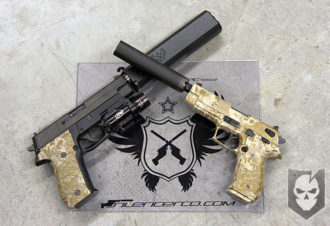
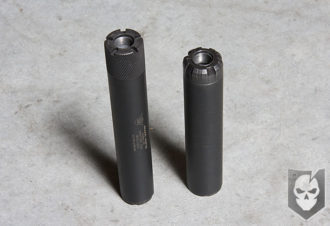
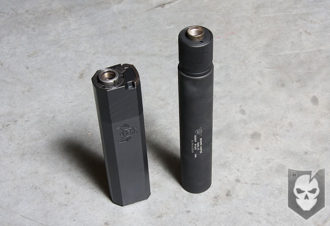
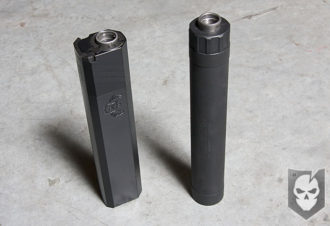
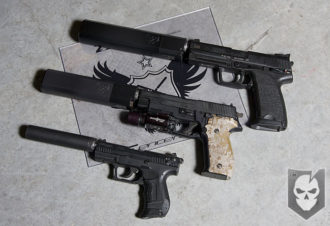






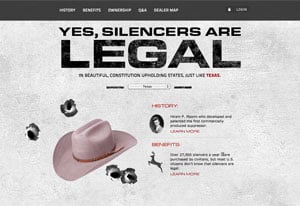
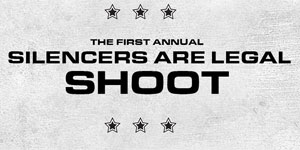
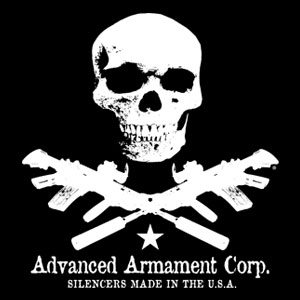
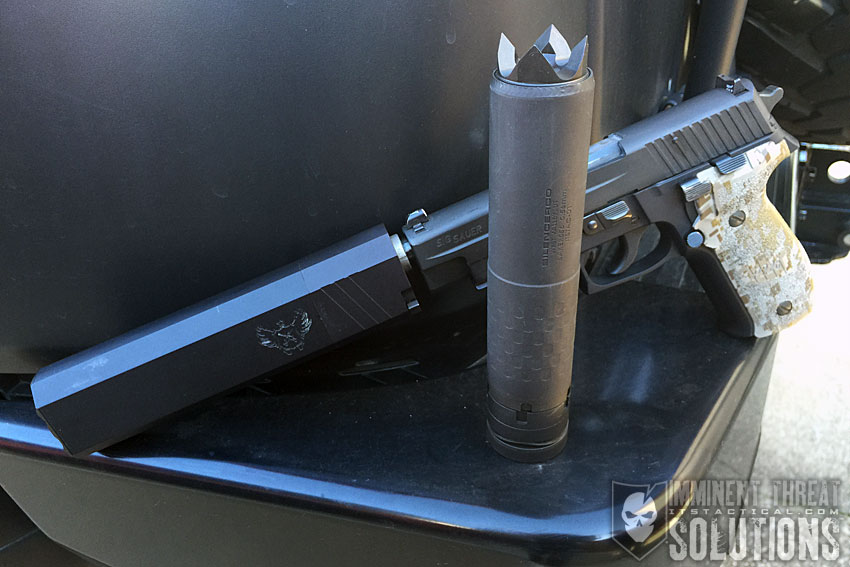

Discussion